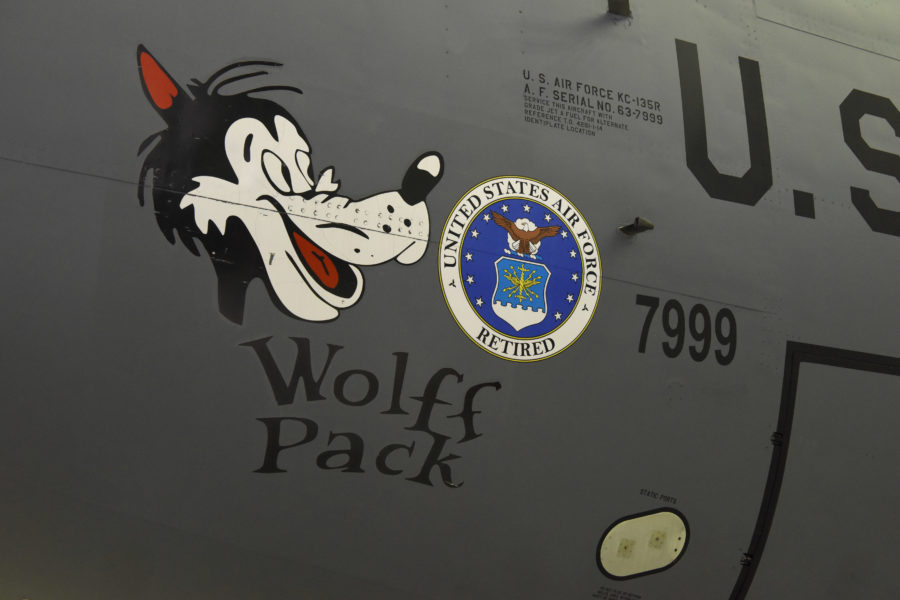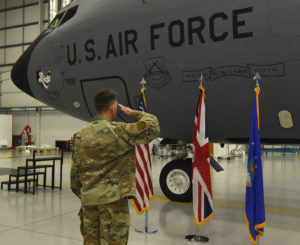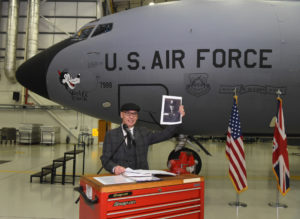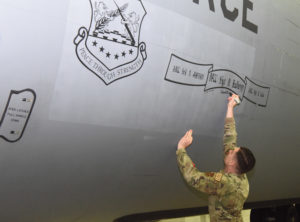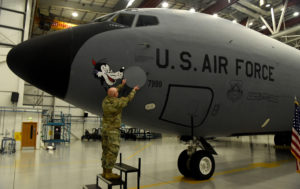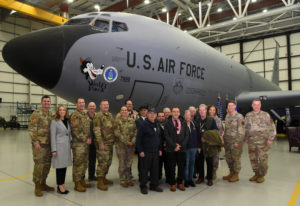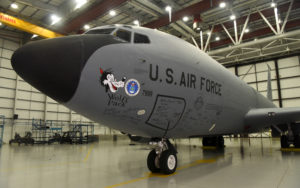The Air Force hosted an unusual retirement ceremony Nov. 23 at RAF Mildenhall in the United Kingdom. Instead of honoring the distinguished career of an Airman, the 100th Air Refueling Wing honored an aircraft. After 59 years, KC-135 Stratotanker tail code 63-7999 transitioned to its next career—the aircraft boneyard at Davis-Monthan Air Force Base, Ariz.
During the retirement ceremony, service members and guests at RAF Mildenhall affixed a retirement “pin” to the aircraft and signed the fuselage before it headed back to the United States. The ceremony was narrated by Staff Sgt. Damon Hadbavny of the 100th Aircraft Maintenance Squadron; presided over by Col. David Hood, the 100th Maintenance Group commander; and featured guest speaker Robert Paley, the 100th Air Refueling Wing’s historian, according to the wing.
The KC-135 tail code 7999 carried “Wolff Pack” nose art in honor of Capt. Robert H. “Bob” Wolff, a pilot with the 100th Bomb Group during World War II. The unit earned the nickname the “Bloody Hundredth” due to extensive losses during the war.
The airplane spent 59 years in service with the U.S. Air Force and was stationed at Al Udeid Air Base, Qatar; McConnell Air Force Base, Kan.; Fairchild Air Force Base, Wash.; and Kadena Air Base, Japan, before going to RAF Mildenhall. It recorded 3,000 sorties and 15,000 flying hours after entering service Nov. 13, 1963, though complete records are unavailable.
It was the first retirement of a KC-135 at RAF Mildenhall, the base said.
The story of the plane’s nose art and its history made the aircraft special to the team at RAF Mildenhall, according to the base. From July 1943, Wolff was stationed at RAF Thorpe Abbotts, a now-defunct air base about 30 miles from RAF Mildenhall. Wolff and his crew—dubbed the “Wolff Pack”—were assigned to the 418th Bomb Squadron within the 100th Bomb Group.
Wolff and his crew were part of a harrowing mission to attack the Regensburg aircraft factory in Germany in a bombing run led by then-colonel Curtis LeMay. Nine aircraft were lost when the bombers came under attack, and Wolff’s B-17 was damaged.
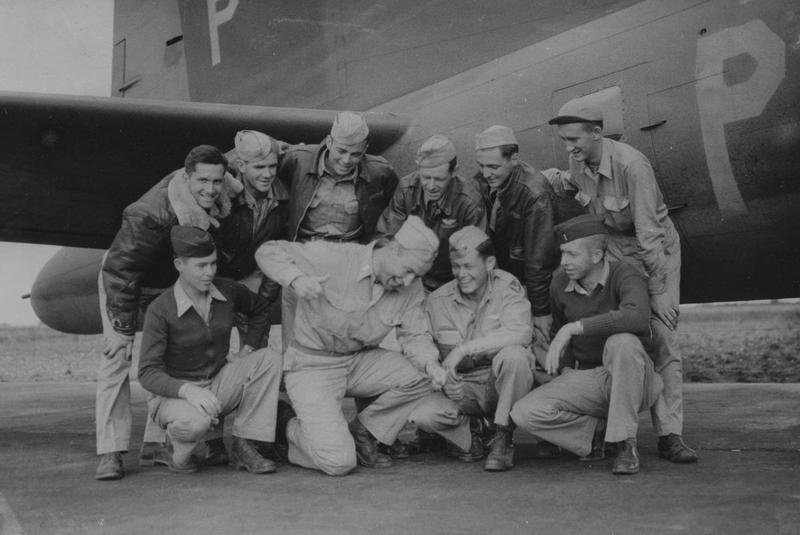
On Sept. 16, 1943, the Wolff Pack were sent on a bombing run to a target in France, but as they attempted to divert to their secondary target due to poor weather, they were hit by enemy fire.
The B-17 turned back toward England but eventually lost three of its four engines.
“We were on fire,” Wolff said in an interview in 2015. “The B-17 won’t fly on one engine.”
Wolff was able to successfully ditch his plane off the coast of France in a water landing, and his crew climbed out.
According to Wolff, he stayed in the cockpit, turning off switches as the plane began to sink.
“Finally, I had enough of that and dove out the window on the pilot’s left side—which is pretty tight—but apparently, I went through it with my metal helmet on and everything else!” Wolff, now 101, said in an Air Force profile of him in 2022.
Originally, Wolff thought he had made it to friendly territory.
“I landed in the water and climbed up on the wing, which was still there,” Wolff said in the 2015 interview. “Here’s this French fishing boat coming, I thought, ‘Oh we’ve got it made.’ I looked around, and there’s this German patrol boat, a 30-foot boat with a machine gun on the bow and a guy standing there, and I thought, oh, four-letter word.”
Wolff was captured by the Germans and sent to Stalag Luft III prisoner of war camp, which was run by the Luftwaffe. After 19 months, Wolff was freed from German captivity. Wolff received the Distinguished Flying Cross and the Air Medal.
“I remember the day one of the 3rd Army tanks came in and knocked the gate down,” Wolff said in 2022. “It was April 29, 1945, and that tank disappeared under the bodies of every guy who could climb on top of it!”
In May of 2012, the 100th Air Refueling Wing unveiled its nose art honoring Wolff and his crew on tail code 7999, the wing said. Other 100th Air Refueling Wing aircraft have nose art honoring crews from the 100th Bomb Group. According to the 100th Air Refueling Wing, Wolff’s plane was shot down before his crew could add “Wolff Pack” nose art to their B-17.
In 2015 Wolff saw the KC-135 that carried the Wolff Pack nose art at a 100th Bomb Group reunion.
“They’ve kept it all these years, and I feel honored,” Wolff said earlier this year. “I had a boat and also named it ‘Wolff Pack,’ with the same insignia. I’ve since sold it, but my son has got a boat and named it ‘Wolff Pack 2’ I guess we want to keep that name with us forever.”
According to the 100th Air Refueling Wing, the name will stay despite the retirement of the KC-135 that carried the moniker.
“Wolff Pack nose art itself will live on at RAF Mildenhall, as it will be transferred to another tanker waiting to bear its legacy nose art,” the wing said.
